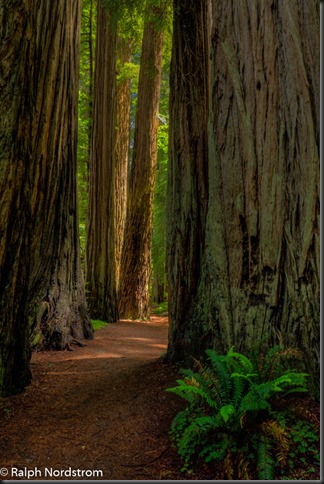Walking among the redwoods is an inspirational experience. But wait, if we’re talking about the redwoods in California, the trees I am thinking about could be 600 miles from the trees that are conjured up in your mind’s eye. That’s because there are two species of redwoods in California – the massive giants found in Sequoia and Kings Canyon National Parks on the western slope of the Sierra Nevada Mountains and the tall ones that hug 450 miles of the fog-shrouded California coast, culminating in the Redwoods National and State Parks of Northern California. While both species are spectacular, each is unique in its own way and photographing them presents dramatically different challenges and opportunities. In this post, I will be taking you through the Coastal Redwoods of Northern California.
The Redwoods National Park was established in 1968. California had already created three state parks, beginning in the 1920s, that encompassed some of the remaining redwood old growth groves – Jedediah Smith, Del Norte Coast and Prairie Creek. The two park systems were joined in 1994 to create the Redwoods National and State Parks. Now 139,000 acres of the Northern California coast are under the joint management and protection of the National Park Service and the California Department of Parks and Recreation.
Being along the Northern California coast, temperatures are moderate throughout the year and moisture is plentiful, not only from winter storms but also from life-giving fogs that roll in year-round from the Pacific Ocean.
Fog is an ever-present possibility in the groves and presents unique challenges and opportunities. The light in the groves is soft and delicate and contrasts and, tp some extent, masks the strength and power of the trees. This light is perfect for capturing this more delicate mood of the redwoods. Slightly overexposed images best capture the lite airiness of the fog. Compositions with strong foregrounds enhance the feeling of depth created by the fog.

The most exciting fog light comes as it begins to clear. This is when the God Rays stream down through the trees. This is thrilling to experience and photograph. But it also poses exposure challenges. The dynamic range can be extreme and the only sure-fire way of capturing these rays and preserving detail in the foreground is HDR.

Many authorities on photographing the redwoods suggest that fog is the only light that can be successfully captured. Some even go so far as to say that when the fog lifts and the sun comes out, scattering dappled splashes of sunlight across the grove floors, it’s time to pack up your gear and head back to the hotel. But dappled sunlight in the groves is magical. The groves take on an entirely different character. Instead of the soft delicate mood created by the fog, the trees become majestic and powerful. They exude strength and tenacity. This light offers the opportunity to capture the towering grandeur of the trees.

The groves themselves take on a different mood – cheerful and joyful. The play of light and shadow throughout the grove is invigorating.
However, the bright splashes of sunlight and the intense blue sky can, once again, create exposure challenges. Fortunately, with digital cameras, HDR is an accessible technique that can capture these challenging conditions, producing rewarding images to complement your memories.
One of the biggest challenges is capturing the enormous height and breadth of these trees. At well over 200 feet and reaching in excess of 300 feet in some groves, how is it possible to capture this on a sensor the size of a 35mm frame of film? A wide-angle lens helps although an effective focal length of 24mm is often not wide enough. And, because these trees are so tall, getting an adequate depth of field can be a challenge. There are so many things to think about.

But even with a wide-angle lens, it’s still difficult to get a sense of scale. Working a person into the composition can help. These are challenges that are fun to tackle.
Every spring the conditions of moisture and the growing warmth of the season come together to spark an outburst of color throughout the groves as the rhododendrons bloom. The contrast of their delicate pink colors against the ruddy, rough trunks of the redwoods captures the union of beauty and strength. To catch the rhododendron boom is an experience as exciting as any you will find in the redwoods. Often the preferred light for flowers is soft open shade or overcast light. However, as shown below, there are conditions where direct sunlight highlights the intricate beauty of these flowers.

As you visit the different groves within the parks, you will see that each has its own unique character. Some grow on hillsides. Others grow in broad valleys. Still others grow on river flood plains. A more subtle challenge is to capture the unique spirit and diversity of each of these diverse environments.
Photographing the coastal redwoods is a unique and stirring experience. Not only is it hugely satisfying but the challenges encountered provide an opportunity for growth as a photographer, both in technical and creative skills, and in an enhanced awareness of and appreciation for this remarkable example of our natural world.
A photography workshop is an excellent way of getting the most out of photographing the magnificent redwoods. I would be honored if you should choose to join me. Click here for more information on this and other workshops.
(275)
